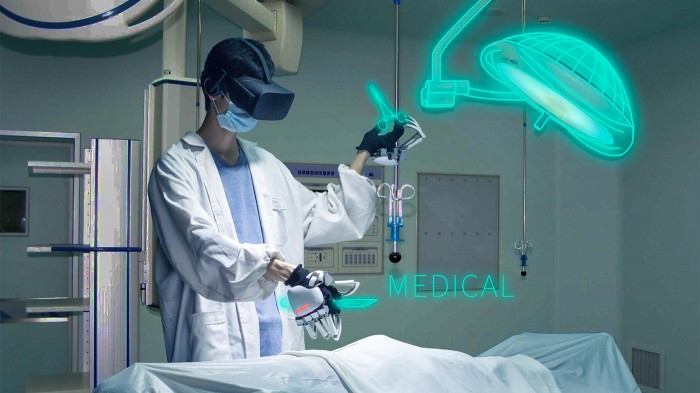This Accessory Makes VR So Real a Surgeon Could Train with It
The Dexmo glove, with its gleaming white carapace and jet-black connecting joints, looks much like a prop stolen from a Stanley Kubrick film set. On your hand, it gives you a cartoonish silhouette, as if some kind of humorous cheat code had been applied to reality to grant humans oversized, clod-like paws.
In fact, Dexmo’s world-altering properties are focused in the virtual realm. Used alongside compatible virtual-reality software, the Dexmo exoskeleton allows its wearer to touch, grasp, and feel virtual objects as if they were real. A virtual baseball feels firm in the hand, an egg fragile. Pick up a digital rubber duck while wearing the Dexmo, and it can be squished pleasingly between the fingers.
The exoskeleton, designed by a team of seven young roboticists and engineers, uses five custom-built force-feedback units to apply torque to your fingers. These motors dynamically alter the direction and magnitude of the force in order to simulate a specific virtual object’s stiffness. In this way they provide light resistance when handling a soft object like a sponge or a piece of cake, and heavy resistance for a denser object, like a pipe or a brick. Tiny motors also provide haptic vibrations to your fingertips that simulate the impact of tapping a keyboard, or running your finger along a piece of rough concrete. The glove’s resistance is so powerful that it will physically prevent your fingers from penetrating through objects in VR.
Aler Gu, the young roboticist who invented the glove and cofounded the company behind it, Dextarobotics, says VR’s sensory expansion into the realm of touch has the power to revolutionize the medium. “The maximum level of feedback current VR controllers give is a gentle rumble using vibration motors,” he says. “But vibration alone isn’t enough to fool the brain. The moment you detect anomalies in how objects feel, your sense of immersion is broken.”
Dexmo’s applications reach far beyond video games, according to Gu. The glove can work in any simulated 3-D environment and is compatible with all of the major VR headsets currently on the market. He also believes that the device will be useful in CAD design, allowing engineers to disassemble rockets and feel the size of each component, or in medical training, where trainee surgeons can perform more realistic operations. It could prove invaluable in training bomb disposal experts and help drastically reduce costs in mechanical maintenance training by providing students with access to otherwise prohibitively expensive parts that they can feel in their hands.
Sam Watts, head of operations at Make Real, a software company that has worked on a variety of VR applications for military clients as well as consumer game publishers, agrees that the current crop of motion-tracked controllers that are sold alongside the major virtual reality headsets “only give the first stage of sensations of touching and interacting with virtual objects.”

The HTC Vive Wands, for example, are held snugly in the hands, like handgun grips. A digital representation of the controller is seen at all times within the virtual world, twisting and moving in perfect sync with your hand motions. “This is fine for games and many forms of training simulation, but for real industrial and engineering adoption of VR, much more realistic and precise feedback is required to accurately convey the sense of touching, using, and manipulating objects together.”
However, Watts says, he needs to see more testing and evidence of consumer adoption of the device before including support for the Dexmo in Make Real’s products.
While the price of a consumer version of the Dexmo is yet to be set, Gu is optimistic that the glove will be something that “eventually everybody should be able to afford.” For now, however, the Dexmo is a tool restricted to the hands of early adopting software developers like Watts, those who will ultimately decide what impact such devices will have on both sides of the screen.
Keep Reading
Most Popular
Large language models can do jaw-dropping things. But nobody knows exactly why.
And that's a problem. Figuring it out is one of the biggest scientific puzzles of our time and a crucial step towards controlling more powerful future models.
How scientists traced a mysterious covid case back to six toilets
When wastewater surveillance turns into a hunt for a single infected individual, the ethics get tricky.
The problem with plug-in hybrids? Their drivers.
Plug-in hybrids are often sold as a transition to EVs, but new data from Europe shows we’re still underestimating the emissions they produce.
Stay connected
Get the latest updates from
MIT Technology Review
Discover special offers, top stories, upcoming events, and more.